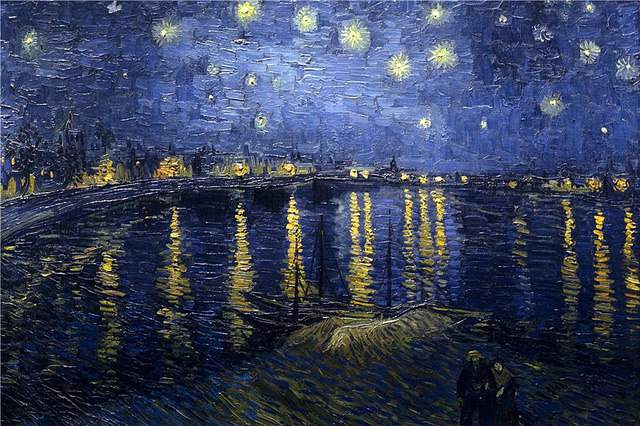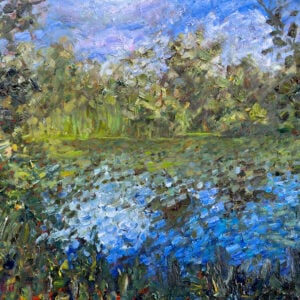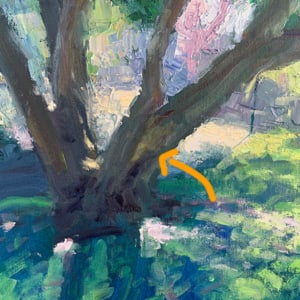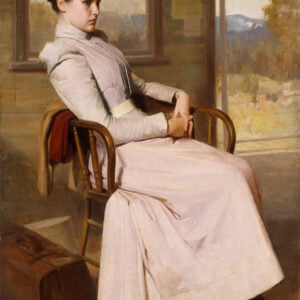One of the first questions you are faced with when you start painting is what medium you should focus on. The three main choices are acrylics, oils and watercolors. For the purpose of this article, I will be discussing the differences between oils and acrylic.
Watercolors are arguably more difficult to pick up due to the untamed nature of water, so I would recommend you start out with either acrylics or oils before venturing into watercolors.
Now is it essential to focus on just one medium? Of course not. But I feel it is more beneficial to aim at mastering just one of the mediums. You will improve naturally across all mediums by doing this.
I will also say there is no correct answer to acrylics versus oils. They are both fantastic mediums with different characteristics.
So let’s get into it – acrylic versus oil painting.
- What Are Acrylic Paints?
- What Are Oil Paints?
- The Key Differences Between Acrylic and Oil Paints
- Which Is More Expensive?
- Which Is More Beginner Friendly?
- Differences in Cleaning
- Is Space an Issue?
- Final Thoughts on Acrylic Versus Oil Painting
- Want to Learn More?
- Thanks for Reading!
What Are Acrylic Paints?
Acrylics are synthetic paints designed to mix and blend just like oils.
Acrylic paint dries extremely fast, to the extent it will dry on your palette if you do not use the paint quick enough. It is less forgiving in this manner and you must be decisive when you paint.
TIP 1: You can keep your acrylic paints from drying for a short period of time by lightly spraying water over your palette (using a spray bottle of some sort).
TIP 2: If you do not like painting for long periods of time, just pick 1-3 colors to use in the session and paint the relevant parts of the painting in those colors. Then you can pack up for the next session, where you will add new colors. This way you are not filling your palette with all the colors of the rainbow only to have them dry on your palette.
Due to the quick drying time, acrylic paint is generally not favored for portrait painting or other subjects where you may want to go back and make subtle adjustments. But the quick drying time does have the benefit of being able to quickly paint layer over layer.
Acrylic paint does not have any ‘fat over lean, thick over thin’ rule (which we will discuss later) and is therefore often favored by beginner painters.

I find there is a bad stigma against acrylic painting, as people tend to think the painting masters only used oil paints. Acrylic paints however have come a long way over the recent years so do not be discouraged from acrylic paints. Acrylic paints were not even available for most of the masters during their times.
With that being said, if you are looking for commercial success early on as an artist, you need to consider whether this ‘stigma’ may influence your chances of selling your paintings.
What Are Oil Paints?
Oil paints are made up of pigment (the color) and oil. Most of the oil paints on the market are poisonous, so always keep them out of the hands of children and be very careful with how you use them.
When painting with oils you will need three main materials:
- Oil Paint
- Medium (Oil)
- Paint Thinner (Solvent)
The oil paint is simply your tube of paint. Paint from the tube is made up of pigment and a small amount of oil which is used as a binder. By adding a medium (more oil) you will be able to paint more fluidly and use less paint from the tube.
The third material is a paint thinner, which as the name suggests, breaks down the oil and thins the paint. Paint thinner was introduced in oil painting to speed up the drying process.
Oil painting involves a steady balance between the amount of oil and paint thinner used.
I will also put here a special mention for odorless solvents. When I started painting, I would almost pass out from the strength of the turpentine solvent I was using. The odorless solvents seem to have no apparent downside and do not have the potent smell.
Most of the famous paintings you may be familiar with are oil paintings. This is due to the versatile characteristics of oil paints combined with the fact acrylic paints were not available during the golden ages of painting, when many of the great masters came to prominence.



The Key Differences Between Acrylic and Oil Paints
There are some key differences between acrylic and oil paints.
- Oil paints have much slower drying times than acrylic paints. You will have more flexibility with oil paints due to longer drying times. Oil paints can take up to a year to dry completely. With acrylic paints, you must be decisive with your strokes, as the paint quickly dries once applied.
- You must paint thick over thin and fat over lean with oil paints. If the top layers of paint dry before the lower layers of paint (the earliest layers applied) then the top layers will crack. The thicker and fatter (oilier) your paint, the slower it dries. Simple as that. Try to have a process in place to ensure each subsequent layer dries slower than the prior. My general rule is to start with a very light wash of paint and solvent. I will then move to 3:1 solvent to oil medium, then for the next layer I will use 2:1 then 1:1 and so on until I am not using any solvent at all. The final layer is usually just highlighting/darkening areas using paint straight from the tube mixed with some oil.
- Acrylic paints darken in color as they dry. Oil paints do not have this problem (however some types of oil paints do get a yellow tinge over time). You will need to account for this change in color whilst using acrylic paints.
- Blending is easier with oil paints. Get friendly with a large blending brush as it will get a lot of use with oil painting. This is one of the main benefits of oil painting. For example, if you are painting a landscape, you will be able to gently blend the mountains in the foreground into the sky, giving it a distant feel. Blending is not as easy with acrylic paints due to the quick drying times.
- You will make a mess with oil paints. Oil paints are much harder to clean and control than acrylic paints. Invest in some quality cleaning materials to make your life easier.
- The finish of oil paint is slightly glossy and refined whilst acrylic paint has a more matte finish.
Which Is More Expensive?
Oil painting tends to be slightly more expensive than acrylic painting due to the number of additional materials required, including:
- Specific cleaning materials
- Oil mediums & solvents
- A wider selection of palette knives (optional)
In addition, I find the paints and paint brushes themselves to be slightly more expensive for oil painting.
With that being said, you can greatly reduce the cost of oil painting with proper cleaning procedures to ensure your paint brushes and materials last a significant period of time.
Tip: If you have just finished your oil painting session and you know you are going to paint again the next day, then you can save yourself some cleaning up time by simply wiping off any mass paint on your paint brushes, dipping the bristles in oil and then just letting them rest. The oil will keep the brushes moist until your next painting session, at which time you can simply give them a gentle wipe and you are good to go again.
Which Is More Beginner Friendly?
Acrylic paint is widely considered to be the most beginner-friendly medium, as it is simple to use, requires very few materials and is much less intrusive on the senses compared to oils.
With that being said, acrylic paint dries very, very fast. This can be extremely difficult to handle as a beginner painter.
Oil paints will be responsive for much longer, with the drying time to touch being anywhere from a day to months.
All you need to start acrylic painting is a canvas, acrylic paints, paint brushes and water. There are however many other accessories to make your life as an acrylic painter easier, such as mediums to help increase the fluidity of your paint without watering it down.
If you are a complete beginner to painting, I would start with acrylics and then consider moving into oils. That is what I did.
Differences in Cleaning
Oil paints are strong and difficult to clean, so much so there are specially designed chemicals with the sole purpose of cleaning oil paints.
Oil paints and solvents can quickly deteriorate your paint brushes if not properly looked after.
Acrylic paints on the other hand generally require nothing more than some soapy water to completely clean your paint brushes and materials.
If you do not have a proper cleaning area or simply do not want the extra hassle of cleaning up after oil painting, then you may prefer to focus on acrylic painting for the time being.
Is Space an Issue?
The amount of studio space you have available may determine whether you focus on acrylics or oils.
I find oils require more room to move for a few reasons:
- The toxicity and odor of oil paints, mediums and solvents do not mix well with confined spaces. Ideally, oil painting should be performed in a spacious, well-ventilated studio.
- Oil paints are much more difficult to clean as compared to acrylic paints, which at most times just requires water.
So if you find yourself only having a small space to paint in, then you may favor acrylic paints due to the ease of clean-up and the weaker odors.
Final Thoughts on Acrylic Versus Oil Painting
Oils and acrylics are both great mediums and you can be a great artist no matter which you decide to focus on. The fundamentals of painting are very similar across both mediums, the main difference is simply the techniques of applying the paint.
If you are completely new to painting and have no preference either way, then I would suggest you play around with acrylics first. They will allow you to learn all the general fundamentals of painting without having to deal with the nuisances of oil painting. Once you have grasped the basics of acrylics, I would then move on to oil paints.
There is nothing stopping you from painting in both mediums, however, I would aim to focus on one of them. It is better to be a master of one medium than to be decent across many mediums.
As far as watercolors go, I would treat that separately to acrylic and oil painting. It is widely considered to be the most difficult medium to pick up due to the volatile nature of water and the very limited amount of work you can perform on watercolor paper.
I hope you found this article useful. At the end of the day, it does not really matter which medium you decide to practice. You will learn most of the same fundamentals regardless. The most important thing is just to start painting!
What medium do you currently paint with? Please add any thoughts to the comment section below.
Want to Learn More?
You might be interested in my Painting Academy course. I’ll walk you through the time-tested fundamentals of painting. It’s perfect for absolute beginner to intermediate painters.
Thanks for Reading!
I appreciate you taking the time to read this post and I hope you found it helpful. Feel free to share it with friends.
Happy painting!
Dan Scott

Draw Paint Academy







I must say that with today’s acrylic mediums which retard drying time, and with the wet palettes one can make or purchase, acrylics are easy to keep moist and active for a full day of painting. However, I never have used oil paints, but I have heard that they can stay blendable for quite some time. For me, I chose acrylics to avoid the “poison” and the smells of turpentine, since I paint in the house in the sunroom. I also love the fast clean up, using just soap and warm water.
Great article! Sometimes it simply comes down to your developed style as an artist. I started out many years ago with acrylics and unknowingly we develop particular styles as artists and I recent realized, I am just totally an oil painter. I am self taught, otherwise an instructor would have pointed this out to me. Loved the article.
Although I began painting with oils due to my interest watching artists on PBS back h the ‘80’s, I moved to watercolors and pencils because they were more mobile. However, I began using acrylics and wondered why I didn’t switch over to that medium sooner. Acrylics are so versatile … add water to do watercolor effects. Get thicker brands and treat it like oils using big brushes and painting knives. Layer as much as you want. And it dries fast, or mist your surface to keep it liquid. Easy clean up. No fuss, no muss. The result? Cost effective and pleasing to the eye.
Hi Jim. Thanks for sharing. You are right – acrylics are great if you are fine with the fast drying times. Dan
Very informative article Dan! I had a dynamite art professor – He talked about outlining the canvas with a certain blocking technique (capturing the main subject, in so many words) using a yellowish-brown tone. I’m rather surprised that the “fat over lean” technique wasn’t discussed though? (Or maybe it was, but I’ve forgotten…that was so long ago.)
Thanks Jennifer. Yes I often stain the canvas with an earth tone at the start. The fat over lean rule varies in importance based on how you paint. If you paint alla prima, you don’t really need to think about the rule all that much. But it is important to understand I think. Thanks! Dan
I love to read your articles, but for this one I have some disagreement. All painting mediums (Oil, Acrylic, Watercolor, Pastel, …etc) are made from the same Pigments but with different binders to bind together for use (i.e., OIls use Linseed Oil, which is not poisonous). If Oil is poisonous, then all other paints are poisonous. I think no matter what paints we choose to use we must use our common sense and caution to protect our own health and environment (don’t eat your paint or even other food while your painting, etc). Another note: most paints are not poisonous after they are binded, even the heavy metal ones like the cobalts and the cadmiums.
Thanks Joyce for pointing that out. I will update the article later on based on your comments. Dan
From the comments above, I see the folks are trying to make their life easier but real masterpieces were made in oil. I always challenge myself, and, therefore, started with oil painting. The first one was just getting the feel on what is about, mixing colors, etc. Some time forward, and I was offered for my painting $6,000 (I have never had any education in art). I did not sell it, and it is still in on the wall in my library.
The latest challenge was a portrait of my granddaughter. Considering the huge break I took between the last painting and this one (35 years!), I was afraid I lost my skills. Nevertheless, after 6 months of work (when I had a mood), the painting was finished and it was a big surprise to my kids and myself included.
So, challenge yourself, folks, you won’t regret.
I think most people avoid oil paint simply because they are intimidated by them and the iconic status they have!, the argument about them being toxic is irrelevant these days as someone else pointed out the Cadmium and Cobalt (even Lead based) paints are only really dangerous in powdered form, or in the hands of someone stupid enough to eat them!, there are plenty of Cadmium and Lead free alternatives available, it is not even necessary to use Turpentine these days as there are many safer solvents on the market, I personally use one called ‘Zest It’ it is completely non-toxic non-flammable, biodegradable, environmentally friendly and smells wonderful like freshly sliced oranges!, there are even water mixable oil paints available, so those who still avoid oil painting on the tired old excuse of them being toxic are not fooling me in the slightest, they just don’t have the courage to try something new.
I have worked in both oils and acrylics, and even as a beginner, I found oils a lot more forgiving and easier to work with. Nowadays there are acrylic paints available of extremely high quality in terms of pigment quality and pigment load. Their main drawback remains the quick drying time.
For me the biggest drawback of oil paintings is the fact that they don’t really stand up against the ravages of time. A close look at old masterpieces like the “Mona Lisa”, “The girl with the pearl earring” and even much later oil paintings reveals surfaces that are severely cracked and brittle. So much so that it is now impossible to remove the yellowed varnish layer on some of these paintings without causing serious damage.
Acrylic paintings, on the other hand, once dry, forms a flexible, yet strong and almost indestructible polymer (plastic) layer in which the pigments are fixed that will neither crack nor discolour, even after 500 years. Only time will tell, but I’m convinced that even after so many years, acrylic paintings will look as fresh as the day after they were finished.
Unfortunately oils still have greater prestige value and art investors and dealers are still prejudiced against acrylic paintings as a good investment. If paint manufacturers can come up with an acrylic paint with the same buttery feel and workability as oils and with slower drying times, I would switch to it in a heartbeat!
I tend to agree with what you said. It is indeed encouraging. But I do feel , oils have proved their worth over so may years, while acrylic is yet to prove itself. There is no doubt about the status that oil enjoys in the society. Acrylic may take some time . Though I do find many artists switching over.
I have been painting in oils for the last about 45 years. It is a wonderful medium to play around. Only problem sometimes I have had is of the oil vapours precipitating my asthmatic problems. That’s why we need to work in open space. I may suggest use of Masks, as we are doing a lot these days, but I am yet to try. Wonder how it effects an artist’s thought process.
Thank you very much for the informative article. I just have a quick question about the brushes. Are they different for oils vrs acrylic?
Thanks !
Yes
Can oils & acrylics be combined on the canvas? In other words, paint a solid block of color in oil, allow it to dry, and then paint acrylic on top of that base oil coloring ?
Hi Robert. You might be able to get away with using oils over acrylics, but I wouldn’t recommend it. Best to just keep them separate if possible. Thanks!
Dan
I am a beginner, your article was a good light to start with , however being a technical persons things are easier for me to understand . Well I restrict myself to acrylic at the moment. I love portraits.
Yes! Great article ..Thank you!
I must admit if it wasn’t for having a good grounding in watercolour I would have found oil painting impossible, I’m in love with oil now but an absolute beginner will struggle.
“an absolute beginner [to oil] will struggle” – so true. I started with acrylics two years ago and have been painting mostly landscapes. Now that I became interested in painting portraits, I switched to oils and I am having an impossible time with them. First of all the smell. I keep the windows open but the smell is still distracting and unpleasant. I also find oil paint too thick and pasty, and even thinning it down with medium does not seem to lend itself to blending well. As determined as I was a few weeks ago to make a go with that, I am thinking of going back to my acrylics. I miss the joy I got our of painting with them – and that’s my reason for painting in the first place.
New member.
I am a long-term water color artist who enjoyed painting detail pictures of, cars, boats, airplanes etc. Now, I am interested in abstracts using palette knife technique. The issue is I can’t decide which medium to use oils or water color. Not really interested in acrilics. Since I am using a palette knife any opinions on oils vs water color would be appreciated… warm regards, Jerry brink of Buhl Idaho
Wanting myself to get back into painting, (since the 70’s…I know…sad, huh) but still very much a beginner I dabbled mostly in water colors. Since then I’ve had the privilege to move over to a few classes of paintings with acrylics in the early 2000’s . But life got busy again 🙁 I have a teenaged granddaughter who is going through a bit of a emotionally challenging time (more than the norm) and was trying to find something that might pique her interest and be enjoyable for her. We came up with painting together and with that being said the first beginner online class I saw that I thought would produce nice results was purchased. The medium used and recommended is water-mixable oils. I’m a bit concerned over the dry time. While they are drying should the pieces be laid flat or can they be upright? Or does it matter? Your info has been very informtive by the way! Since the purpose is to have fun and learn some new techniques, I’m hoping that I am moving in the right direction. I was only concerned about having a piece she may be proud of but not being able to do anything with it for a half of a year. So, hence my question.
I enjoyed the article and every one of the comments. My question is this. When learning to mix Acrylics for a particular shade will those same proportions be the same for oils? Years ago I began with oils for a year or so then quit and since gave all my brushes, paints etc to my granddaughter. I just got so busy with earning a living. To day having been retired for sometime and the state of the union making me sick and to keep my sanity I have undertaking a drawing course from “WONDRIUM” off the TV and many good articles from the Internet. I will be relearning but this time with Acrylics. I will not be mixing acrylics and oils… yep, oil and water doesn’t mix Comments can be sent to my email at purplearrow9@yahoo.com. Thank you all for suggestions. Will be 82 years young come JULY 21st.2022